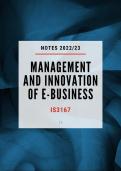Lecture notes
NOTES IS3167 - Management and Innovation of e-business
- Module
- IS3167 (IS3167)
- Institution
- London School Of Economics (LSE)
Notes for the London School of Economics course 'Management and Innovation of E-Business (IS3167)'. These notes span chapters 2 to 8 and are derived from official course sources such as the course textbook, subject guide, and lecture materials, ensuring you have a thorough understanding of the ...
[Show more]



